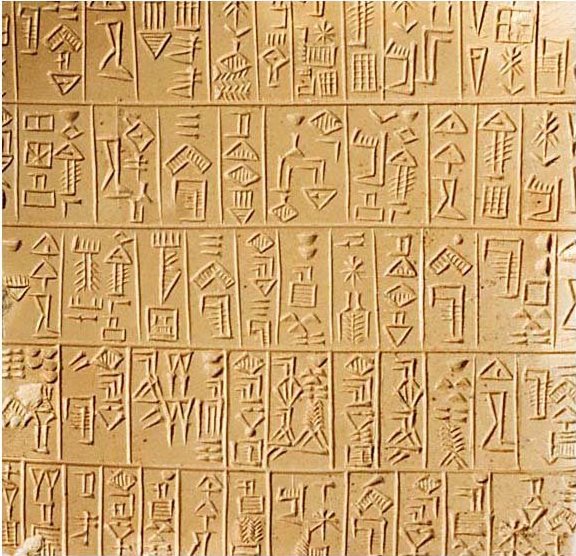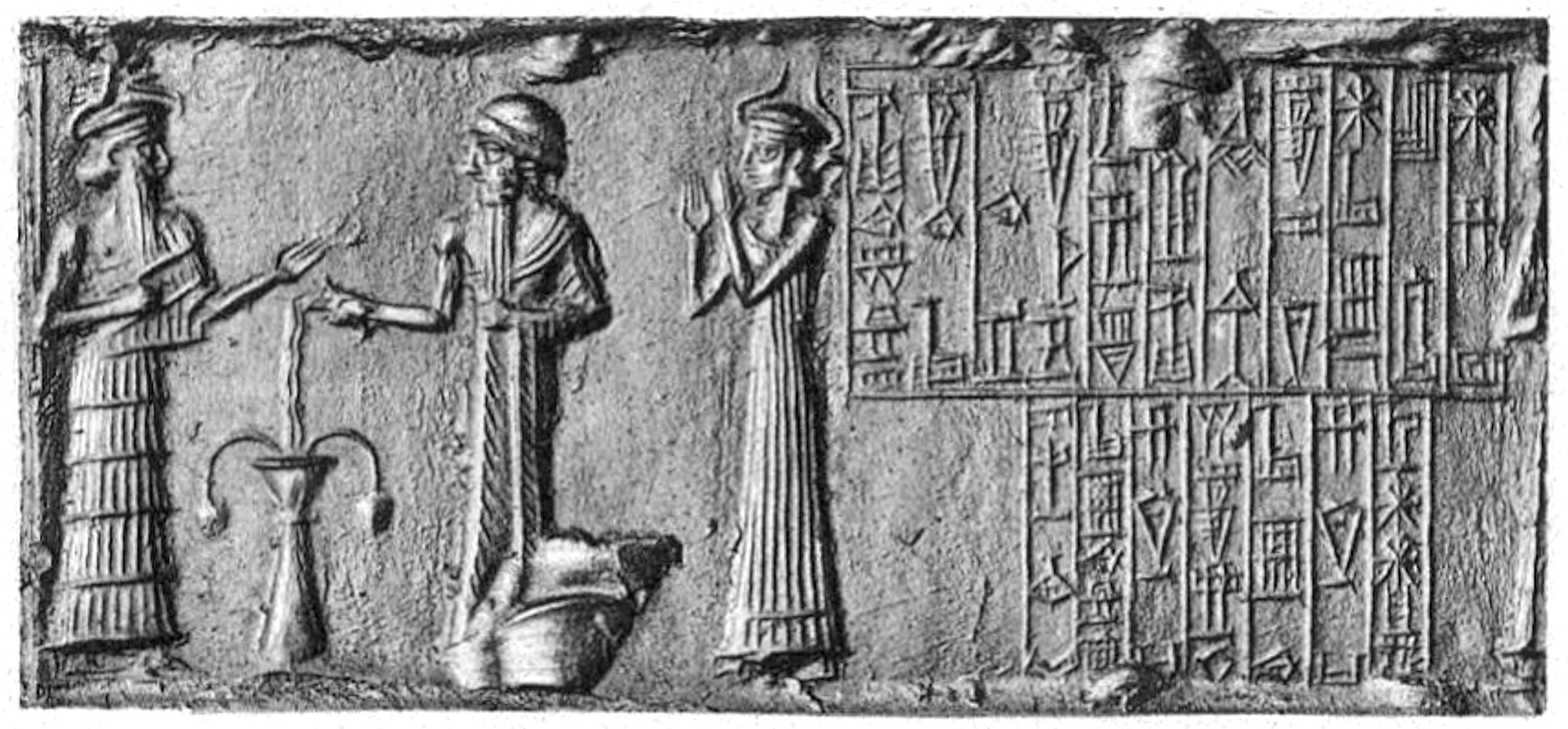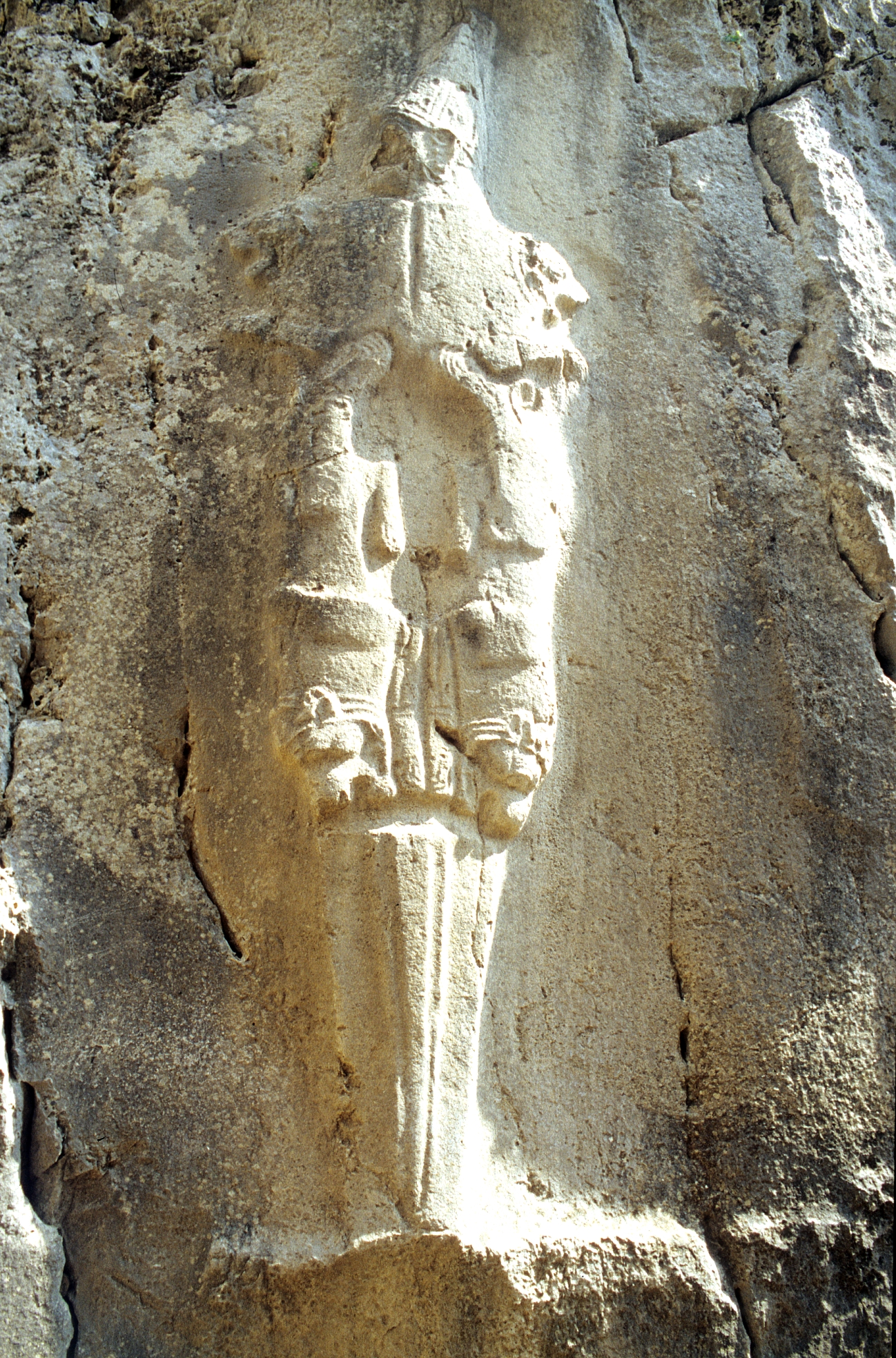|
Dimmeku
Dimmeku (also read as Dimpimeku), Dimku or Ḫedimku was a Mesopotamian goddess or demon associated with the underworld. From the Old Babylonian period on she was associated with Namtar, and in the god list ''An = Anum'' she appears as his daughter. It has been suggested that the similarly named Ḫedimmeku, who is attested in the same source as a daughter of Enki, was identical with her, though this conclusion is not universally accepted. Name and character The oldest variants of the name, '' ddìm-''PI''-ku'' (''d.dìmdimme-ku'') from the compositions ''The Death of Ur-Namma'' and '' The Death of Gilgamesh'' and ''ddìm''-PI.ME-''ku'' (''d.dìmdimmeme-ku'') from the Nippur god list, according to Dina Katz should be read as Dimmeku. This conclusion is also supported by Jeremiah Peterson. However, the readings Dimpiku and Dimpimeku can be found in older literature. In the incantation series ''Udug-hul'' the form ''ddìm-kù'', Dimku, occurs. Later sources spell the name as ''dḫé ... [...More Info...] [...Related Items...] OR: [Wikipedia] [Google] [Baidu] |
Namtar
Namtar () was a figure in ancient Mesopotamian religion who, depending on the context, could be regarded both as a minor god and as a demon of disease. He is best attested as the sukkal (attendant deity) of Ereshkigal, the goddess of the underworld. Like her, he was not the object of active worship, though references to it are made in literary texts, and additionally some incantations entrust him with keeping various other malevolent forces in the underworld. Character and functions Namtar's name means "fate" in Sumerian. It can be differentiated from the ordinary word "fate" in Sumerian texts due to being preceded by the dingir sign, so-called divine determinative, used to identify the names of deities. The same name was used in Akkadian, written as ''dnam-ta-ru''. Jacob Klein notes that true to his name, Namtar was most likely understood as the personification of unavoidable fate, implicitly understood as death. Aicha Rahmouni compares the role of Namtar in Mesopotamian beliefs ... [...More Info...] [...Related Items...] OR: [Wikipedia] [Google] [Baidu] |
Ninazu
Ninazu (; DNIN.A.SU">sup>DNIN.A.SU"lord healer") was a Mesopotamian god of the underworld. He was also associated with snakes and vegetation, and with time acquired the character of a warrior god. He was frequently associated with Ereshkigal, either as a son, husband, or simply a member the same category of underworld deities. His original cult centers were Enegi and Eshnunna, though in the later city he was gradually replaced by a similar god, Tishpak. His cult declined after the Old Babylonian period, though in the city of Ur, where it was introduced from Enegi, he retained a number of worshipers even after the fall of the last Mesopotamian empires, in the Achaemenid period. Character and iconography According to Julia M. Asher-Greve, Ninazu was initially considered a "high-ranking local god", similar in rank to Ningirsu. His name has Sumerian origin and can be translated as "lord healer", though he was rarely associated with medicine. It is nonetheless agreed that he ... [...More Info...] [...Related Items...] OR: [Wikipedia] [Google] [Baidu] |
Mesopotamian Goddesses
Deities in ancient Mesopotamia were almost exclusively Anthropomorphism, anthropomorphic. They were thought to possess extraordinary powers and were often envisioned as being of tremendous physical size. The deities typically wore ''melam'', an ambiguous substance which "covered them in terrifying splendor" and which could also be worn by heroes, kings, giants, and even demons. The effect that seeing a deity's ''melam'' has on a human is described as ''ni'', a word for the "Paresthesia, physical creeping of the flesh". Both the Sumerian language, Sumerian and Akkadian languages contain many words to express the sensation of ''ni'', including the word ''puluhtu'', meaning "fear". Deities were almost always depicted wearing horned caps, consisting of up to seven superimposed pairs of ox-horns. They were also sometimes depicted wearing clothes with elaborate decorative gold and silver ornaments sewn into them. The ancient Mesopotamians believed that their deities lived in Heaven, ... [...More Info...] [...Related Items...] OR: [Wikipedia] [Google] [Baidu] |
Electronic Text Corpus Of Sumerian Literature
The Electronic Text Corpus of Sumerian Literature (ETCSL) is an online digital library of texts and translations of Sumerian language, Sumerian literature that was created by a now-completed project based at the Oriental Institute, Oxford, Oriental Institute of the University of Oxford. This project's website contains "Sumerian text, English prose translation and bibliographical information" for "over 400 literary works composed in the Sumerian language in ancient Mesopotamia (modern Iraq) during the late third and early second millennia BCE." It is both browsable and searchable and includes transliterations, composite texts, a bibliography of Sumerian literature and a guide to spelling conventions for proper nouns and literary forms. The purpose of the project was to make Sumerian literature accessible to those wishing to read or study it, and make it known to a wider public. The project was founded by Jeremy Black (assyriologist), Jeremy Black in 1997 and is based at the Orient ... [...More Info...] [...Related Items...] OR: [Wikipedia] [Google] [Baidu] |
Shulgi
Shulgi ( dšul-gi,(died c. 2046 BC) formerly read as Dungi) of Ur was the second king of the Third Dynasty of Ur. He reigned for 48 years, from (Middle Chronology). His accomplishments include the completion of construction of the Great Ziggurat of Ur, begun by his father Ur-Nammu. On his inscriptions, he took the titles "King of Ur", " King of Sumer and Akkad", adding " King of the four corners of the universe" in the second half of his reign. He used the symbol for divinity ( ) before his name, marking his apotheosis, from at least the 21st year of his reign and was worshipped in the Ekhursag palace he built. Shulgi was the son of Ur-Nammu king of Ur and his queen consort Watartum. Life and reign Shulgi apparently led a major modernization of the Third Dynasty of Ur. He improved communications, reorganized the army, reformed the writing system and weight and measures, unified the tax system, and created a strong bureaucracy. He also wrote a law code, now known as the ... [...More Info...] [...Related Items...] OR: [Wikipedia] [Google] [Baidu] |
Ur III Period
The Third Dynasty of Ur or Ur III was a Sumerian dynasty based in the city of Ur in the 22nd and 21st centuries BC (middle chronology). For a short period they were the preeminent power in Mesopotamia and their realm is sometimes referred to by historians as the Neo-Sumerian Empire. The Third Dynasty of Ur is commonly abbreviated as "Ur III" by historians studying the period. It is numbered in reference to previous dynasties, such as the First Dynasty of Ur (26-25th century BC), but it seems the once supposed Second Dynasty of Ur was never recorded. The Third Dynasty of Ur was the last Sumerian dynasty which came to preeminent power in Mesopotamia. It began after several centuries of control, exerted first by the Akkadian Empire, and then, after its fall, by Gutian and independent Sumerian city-state kings. It controlled the cities of Isin, Larsa, and Eshnunna and extended as far north as Upper Mesopotamia. The Ur III provinces, from north to south were Sippar, Tiwe, Urum, Pu� ... [...More Info...] [...Related Items...] OR: [Wikipedia] [Google] [Baidu] |
Apsû
Abzû or Apsû (Sumerian language, Sumerian: ; Akkadian language, Akkadian: ), also called (Cuneiform:, ; Sumerian language, Sumerian: ; Akkadian language, Akkadian: – recorded in Greek as ), is the name for fresh water from underground aquifers which was given a religious fertilising quality in ancient near eastern cosmology, including Sumerian religion, Sumerian and Akkadian literature#Mythology, Akkadian mythology. It was believed that all lakes, springs, rivers, fountains, rain, and even the Great flood, Flood, as described in Atra-Hasis, Atrahasis, originated from the Abzû. In Mesopotamian cosmogony, it is referred to as the freshwater primordial ocean below and above the earth; indeed the Earth itself was regarded as a goddess ''Ninhursag'' that was conceived from the mating of male Abzu with female saltwater ocean ''Tiamat''. Thus the divine Mother Earth – on her surface equipped with a bubble of breathable air – was surrounded by Abzû, and her interior ... [...More Info...] [...Related Items...] OR: [Wikipedia] [Google] [Baidu] |
Wilfred G
{{disambiguation, surname ...
Wilfred may refer to: * Wilfred (given name), a given name and list of people (and fictional characters) with the name * Wilfred, Indiana, an unincorporated community in the United States * ''Wilfred'' (Australian TV series), a comedy series * ''Wilfred'' (American TV series), a remake of the Australian series * ''Wilfred'' (Thames barge) * Operation Wilfred, a British Second World War naval operation People with the surname * Harmon Wilfred, stateless businessman in New Zealand * Thomas Wilfred (1889–1968), Danish musician and inventor See also * Wilf * Wilfredo * Wilfrid ( – ), English bishop and saint * Wilfried * Wilford (other) Wilford is a village in Nottinghamshire, England. Wilford may also refer to: Places * Wilford, Arizona, a ghost town in the United States * Wilford, Idaho, an unincorporated community in the United States *Wilford, a townland in County Mayo, Ire ... [...More Info...] [...Related Items...] OR: [Wikipedia] [Google] [Baidu] |
Ugur (god)
Ugur was a Mesopotamian god associated with war and death, originally regarded as an attendant deity (''sukkal'') of Nergal. After the Old Babylonian period he was replaced in this role by Ishum, and in the Middle Babylonian period his name started to function as a logogram representing Nergal. Temples dedicated to him existed in Isin and Girsu. He was also worshiped outside Mesopotamia by Hurrians and Hittites. He might also be attested in sources from Emar. Name and character Ugur's name was written in cuneiform as dU.GUR. It is alternatively romanized as Uqur or Ukur. Jeremiah Peterson notes that an Old Babylonian exemplar of the Weidner god list appears to preserve a variant spelling, dU.GU2, which supports the reading Ugur. A bilingual god list from Emar phonetically transcribes it in Hurrian as ''du-ku-ur-un''. According to Manfred Krebernik and Volkert Haas its origin and meaning are not fully certain. It has been proposed that it was the imperative form of Akkadian ''n� ... [...More Info...] [...Related Items...] OR: [Wikipedia] [Google] [Baidu] |
Gilgamesh
Gilgamesh (, ; ; originally ) was a hero in ancient Mesopotamian mythology and the protagonist of the ''Epic of Gilgamesh'', an epic poem written in Akkadian during the late 2nd millennium BC. He was possibly a historical king of the Sumerian city-state of Uruk, who was posthumously deified. His rule probably would have taken place sometime in the beginning of the Early Dynastic Period, 2900–2350 BC, though he became a major figure in Sumerian legend during the Third Dynasty of Ur (). Tales of Gilgamesh's legendary exploits are narrated in five surviving Sumerian poems. The earliest of these is likely "Gilgamesh, Enkidu, and the Netherworld", in which Gilgamesh comes to the aid of the goddess Inanna and drives away the creatures infesting her ''huluppu'' tree. She gives him two unknown objects, a ''mikku'' and a ''pikku'', which he loses. After Enkidu's death, his shade tells Gilgamesh about the bleak conditions in the Underworld. The poem '' Gilgamesh and Aga'' de ... [...More Info...] [...Related Items...] OR: [Wikipedia] [Google] [Baidu] |
Etana
Etana (, ''E.TA.NA'') was the thirteenth king of the first dynasty of Kish, according to the ''Sumerian King List''. He is listed as the successor of Arwium, the son of Mashda, as king of Kish. The list also calls Etana "the shepherd, who ascended to heaven and consolidated all the foreign countries", and states that he ruled 1,560 years (some copies read 635) before being succeeded by his son Balih, said to have ruled 400 years. The kings on the early part of the ''SKL'' are usually not considered historical, except when they are mentioned in contemporary Early Dynastic documents. Etana is one of them. Myth of Etana A Babylonian legend says that Etana was desperate to have a child, until one day he helped save an eagle from starving, who then took him up into the sky to find the plant of birth. This led to the birth of his son, Balih. In the detailed form of the legend, there is a tree with the eagle's nest at the top, and a serpent at the base. Both the serpent and eagl ... [...More Info...] [...Related Items...] OR: [Wikipedia] [Google] [Baidu] |
Bitu (god)
Bitu or Bidu (formerly read Neti or Nedu) was a minor Mesopotamian god who served as the doorkeeper of the underworld. His name is Akkadian in origin, but he is present in Sumerian sources as well. Name The spellings Bitu and Bidu are both used in modern scholarship. The name of the gatekeeper of the underworld was written in Sumerian as dNE.TI. In older sources, it was read as Neti. The reading Bidu has been established by Antoine Cavigneaux and Farouk al-Rawi in 1982 based on the parallel with the syllabic spelling Bitu (''bi-tu''). Multiple other syllabic spellings are attested, including ''bí-ti'', ''bí-du8'', ''bí-duḫ'' and ''bi-ṭu-ḫi''. Michael P. Streck suggests that the forms with ''du8'' should be understood as a learned spelling based on the meaning of this cuneiform sign, "to loosen," and on the Sumerian word for a gatekeeper, ''ì-du8''. The name is however derived from the imperative form of Akkadian ''petû'', "open." Based on this etymology Dina Katz a ... [...More Info...] [...Related Items...] OR: [Wikipedia] [Google] [Baidu] |




